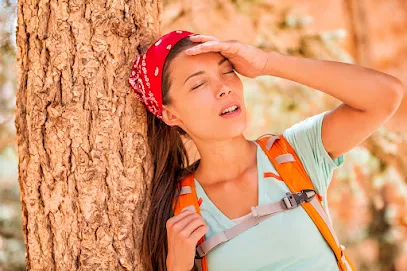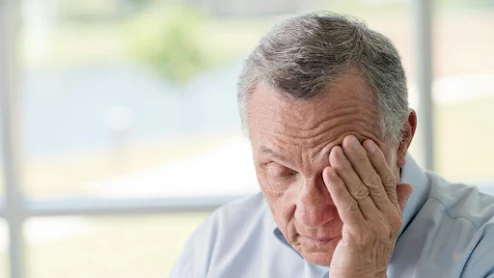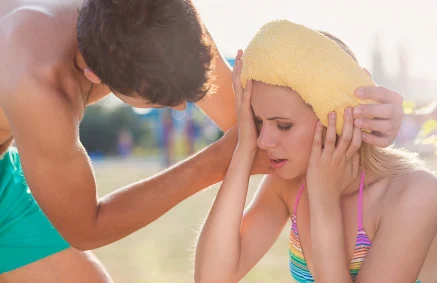How to Avoid Dehydration and Heat stroke - Heat Stroke Symptoms
As weather forecasters issue warnings about the the extreme heat, take those threats seriously: Steamy temperatures can kill.
RELATED: 15 Common Symptoms of Dehydration (#8 Surprised me Completely)
More than 450 people died in 2017 because of what the Centers for Disease Control and Prevention calls exposure to excessive natural heat, and almost two-thirds were 50 and older. Agency officials say those numbers are likely low because heat waves can worsen existing health conditions, so a cause of death may be listed as a heart attack, but it might have been brought on by high temperatures.
Everyone should know about these things when summer weather starts scorching.
We are quite literally what we drink. Our bodies are mostly (about 60 percent) water, and we can’t live more than a few days without it. There is no universally accepted rule of thumb for how much, exactly, each of us should drink, despite how often we’ve been told to consume eight 8-ounce glasses a day, or 64 ounces total. The National Academy of Medicine recommends that adult men drink about 15 cups (125 ounces) of fluid a day and women 11 cups (91 ounces), but experts say the ideal amount can vary widely depending on factors including a person’s weight, health and activity level.
By the time you’re thirsty, you’re likely to have lost around 1 or 2 percent of your body’s fluid, so a key measure of dehydration is thirst. But this warning system doesn’t always function well in older adults, says Kumar Dharmarajan, a geriatrician and chief scientific officer at San Francisco–based insurer Clover Health, who explains that as people age they are less able to perceive their own thirst, “so when they need water, they’re less likely to respond to it.”
RELATED: How To Quench Thirst Without Water Or Food?
How to tell if you’re dehydrated
In addition to thirst, your urine color can indicate dehydration. When urine is dark, it’s a sign that it is more concentrated due to less fluid in your body. “It should look more like lemonade, less like apple juice,” says Luke Belval, director of research at the University of Connecticut’s Korey Stringer Institute, which focuses on safety in sports. “We’re shooting for that pale, straw-colored urine.”
Another self-evaluation Belval recommends: Weigh yourself every morning. If you find that you’ve lost a pound or two from the day before, you are probably dehydrated — apologies to dieters — “because, in general, gross changes in body mass don’t happen that quickly.”
Signs of more severe dehydration can include a dry mouth, headache, decreased urine output, increased pulse, lack of sweat, irritability, and feeling fatigued, nauseous, lightheaded or dizzy.
How to prevent dehydration
Drink frequently throughout the day. “Rather than wait until you feel bad and drink a ton of fluid, it’s better to maintain your hydration by drinking regularly,” advises Raj Deu, M.D., assistant professor of orthopedic surgery at the Johns Hopkins University School of Medicine.
One thing preventing some people from drinking enough water, of course, is not having easy access to a bathroom. “Often they will restrict how much they drink and end up being dehydrated,” Deu observes. It can be a big problem for athletes, who may not be able to take bathroom breaks during practice or games, as well as for older men, who already may find that they need to urinate more frequently (a common issue as the prostate enlarges with age). “If you throw in drinking a ton of fluid, they’re going to be running to the bathroom an awful lot,” he says.
There’s no great solution when bathrooms are scarce, Deu adds, but his best advice would be to try to maintain a steady hydration level, rather than drink a large amount of liquid at once.
ALSO READ: How Much Water Should You Drink Per Day?
Experts also recommend avoiding alcohol, which is dehydrating, and being careful with caffeine, a mild diuretic, which means it causes you to eliminate an increased amount of fluid from your body.
And, yes, it is possible to drink too much water. Hyponatremia occurs when you drink so much fluid that you dilute the sodium level in your blood, which can lead to severe medical problems or death. But it’s rare, being associated most often with marathon runners who guzzle water repeatedly along their route without periodically urinating.
Heat Exhaustion and Heatstroke
Heat can make you sick — and can quickly become life-threatening. The milder problem is heat exhaustion, which occurs when your internal body temperature begins rising too high. You may experience sudden fatigue and dizziness as your blood pressure rises, and some people experience a change in mood — symptoms that shouldn’t be taken lightly but that can usually be addressed without medical intervention.
The University of Connecticut's Belval says, “Generally, if you bring the person into the shade, elevate their legs and give them some water to drink, they recover pretty quickly.” (Elevating the individual's legs helps blood pressure to normalize.)
READ MORE: One Month Before Stroke Your Body Will Send You These Warning Signs
Heatstroke, however, is a true medical emergency, and if not treated quickly, it can lead to death. It’s heatstroke when a person’s body temperature gets so high — typically more than 104.5 or 105 degrees — that the organs shut down and the person can become unconscious. If you’re assisting someone in this situation, call 911, Belval says, and “cool the person down as quickly as possible, covering their body with as much ice water as you can.”
Heatstroke can occur in high heat with heavy exertion (a 30-year-old man running a race in New York state in the heat reportedly died after his body temperature reached 108 degrees) or more gradually, after days spent in a hot environment — for example, someone who’s stuck at home alone without air-conditioning during a heat wave.
Along with, and partly because of, their higher risk of dehydration, older people are more susceptible to such heat-related illnesses, Dharmarajan explains. Older adults don’t sweat as easily as younger people and are “less able to dilate the blood vessels in their skin to emit heat from their bodies” to cool themselves down.
Older people also may have medical conditions or be taking medications (such as diuretics) that can impair a body’s ability to regulate heat, says Dharmarajan: “It sort of can be like a double whammy because the medication is pushing the body in one direction but so is the sun and the heat.”
How to prevent heat-related illnesses
Wear light, loose-fitting clothing that allows the body to breathe.
Drink plenty of water, and avoid alcohol and caffeine. If you’re going to be exercising in the heat, sip water throughout your workout and consider bringing a damp towel packed in ice to cool yourself off.
Spend as much time as possible in air-conditioned spaces. If you don’t have air-conditioning at home, go to cool public places like libraries. “A fan isn’t going to cut it if it’s really hot,” says Dharmarajan.
Stay out of middle-of-the-day heat and use sunscreen; sunburn can cause dehydration and a diminished sweating response, says Belval.
As soon as you start feeling tired and short of breath, stop, rest and hydrate.
Drink water and be safe from heatstroke. Stay safe.








.jpg)




.jpeg)

Nice presentation doctor 👍